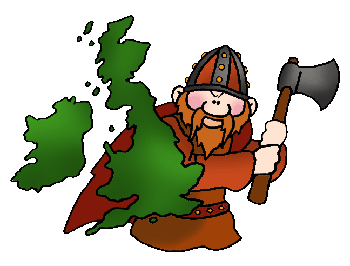The Anglo Saxons
During the 400s, Germanic tribes (Angles, Saxons, Jutes, Friesians) came from continental Europe and settled in the British Isles after the fall of the Roman Empire. Descendants of these immigrants came to be known as Anglo-Saxons. They ruled Britain for 600 years and made lasting changes in language, culture and politics.


Early Settlement
Angles, Jutes and other Germanic tribes may have served in the Roman army under Roman rule in Britain, so they already knew the region. As the Roman Empire fell apart and Roman legions withdrew, small parties of Germanic tribes began invading.
Some Britons resisted the new settlers. Their stories may have inspired the legends of King Arthur. Still, migration into the British Isles continued. The Angles, Saxons and other Germanic tribes brought their own languages and replaced Roman stone buildings with new wooden ones. They also brought their own religious beliefs.
The earliest settlers organized themselves into tribal groups and then formed small kingdoms, including:
Kent – Settled mostly by Jutes, Kent became the first Anglo-Saxon kingdom to convert to Christianity.
East Anglia – Settled mostly by Angles, it later became part of Mercia.
Northumbria – The most powerful Anglo-Saxon kingdom of the 7th century was home to the monk, Bede. He wrote one of the great works of Anglo-Saxon literature: The Ecclesiastical History of Britain
Mercia – King Offa helped make Mercia one of the most powerful Anglo-Saxon kingdoms of the 8th century. He built Offa’s Dyke, a 150 mile long earthen fortification along the English-Welsh border. It is still visible today.
Wessex – After challenging Mercian control, Wessex faced Viking invasions. King Alfred the Great of Wessex was the only King able to defeat the Danish Vikings at the time. Other Anglo-Saxon kingdoms came under Danish rule.

King Athelstan
Grandson of Alfred the Great, King Athelstan became the first king of all England and ruled between 925 and 939. After taking back territory from the Danes, he forced kings in Scotland and Wales to submit to his rule.

Christianity
The Roman Empire brought early Christian influences to the British Isles. Saint Patrick is credited with spreading Christianity in Ireland during the 400s. Then Ireland founded religious communities in Scotland and northern and eastern Britain. One of the most famous was Lindisfarne in Northumbria. Many Anglo-Saxons in northern kingdoms came under the influence of Christianity through the Irish (Celtic) Church.
Meanwhile, around 587, Pope Gregory sent Augustine to convert the Anglo-Saxons. The king of Kent, married to a Frankish Christian princess, gave him land to build a church and found the See of Canterbury. By that time, the northern and eastern regions had already been converted by the Irish Church. Saint Winifred converted remaining pagan areas of Sussex and the Isle of Wight between 681 and 683.
Kings may have been the earliest converts to Christianity. Local inhabitants probably followed more slowly.

Towns
Alfred the Great encouraged the building of fortified towns (burhs or burgs) to protect Britain from further Danish invasions. He wanted no place in Wessex to be further than 20 miles from a town. In exchange for free plots of land, settlers in the town agreed to help defend them. Some towns were built on older Roman settlements. Others were new. Many of these Anglo-Saxon towns grew into well-known modern cities of England, including:
• Oxford
• Exeter
• Warwick
• Worcester
• Southampton
• Winchester

Language
Angles, Saxons and Jutes all spoke different dialects. Over time, their language blended into what we now call Old English. About one-third of Anglo-Saxon vocabulary continues into modern English.
400 Anglo Saxon texts survive to this day. The most famous is Beowulf, an epic poem about the battle between a prince and a monster named Grendel.
Many Old English words are kennings where two words are combined to create a poetic new word. Beowulf contains over a thousand kennings. Here are a few:
• bone-house – the human body
• battle-light – sword
• battle-sweat – blood
• wave-floater – ship
• sleep of the sword – death
• whale-road – the sea

The Norman Conquest
Vikings continued raiding in England and took back Anglo-Saxon territory in 1013. For a short time, England became part of an empire ruled by the Danish king, Knut, that also included Denmark and Norway
Edward the Confessor won the English throne back from Danish rule. In a battle near York, his armies defeated the last great Viking king in English territory. But battles against Vikings weakened Anglo-Saxon armies. Weeks after the battle at York, they faced a new invasion. In 1066, England fell to William the Conqueror, Duke of Normandy, and a new era of British history began.



